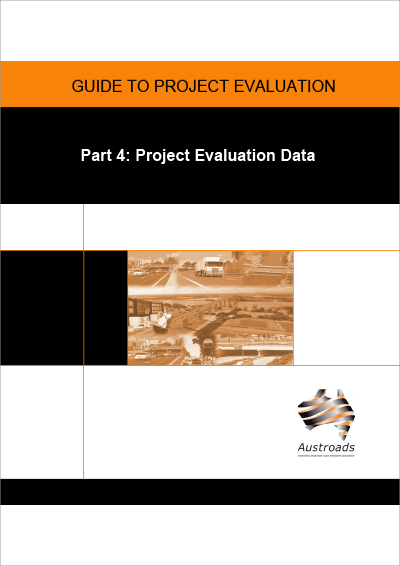Economics and Financing

- Publication no: AGPE04-12
- ISBN: 978-1-921991-36-3
- Published: 6 August 2012
- Edition: 4
- Superseded
- PDF (free) Download
This Guide contains estimates of road user unit costs for use in Australia, calculated as at 30 June 2010. The unit costs are presented in a format suitable for use with most road project evaluation models, techniques, and software used by Australian road agencies and their consultants. Estimates are not intended for use in New Zealand. Unit values have been calculated in ‘resource price’ terms that is, excluding indirect taxes and government charges, but including subsidies paid to producers. Estimates of road user cost (RUC) inputs are provided at an individual component level for the following cost groupings: vehicle operating costs, travel time costs, crash costs and environmental externalities costs. Average crash costs are now reported for individual jurisdictions and the potential for extending the updating procedure to include crash costs based on road user movement and speed zones is also considered. Finally, updated parameter values for running speed models used to estimate vehicle operating costs and fuel usage for urban operations are supplied, based on a reduced formrelationship derived from urban RUC models.
- SUMMARY
- 1. INTRODUCTION
- 2. VEHICLE OPERATING COSTS
- 2.1. Fuel Prices
- 2.1.1. Concepts and Data Source
- 2.1.2. Methodology
- 2.1.3. Fuel Price Estimates for Capital Cities
- 2.1.4. Fuel Price Estimates for States and Territories
- 2.2. Lubricating Oil
- 2.2.1. Passenger Vehicles
- 2.2.2. Heavy Vehicles
- 2.3. Tyre Prices
- 2.3.1. Car Tyre Prices
- 2.3.2. Heavy Vehicle Tyre Prices
- 2.3.3. Rethread Tyre Prices
- 2.4. Vehicle Prices
- 2.4.1. Car Prices
- 2.4.2. Truck and Coach Prices
- 2.5. Vehicle Repair and Maintenance Costs
- 3. TRAVEL TIME VALUATION
- 3.1. Occupancy Rates
- 3.2. Value per Occupant for Cars
- 3.3. Value per Occupant for Heavy Vehicles
- 3.3.1. Transport Workers Award
- 3.3.2. Payroll Tax
- 3.3.3. On-cost Items
- 3.3.4. Value per Occupant
- 3.4. Value per Occupant for Buses
- 3.5. Freight Travel Time
- 3.6. Development Work
- 4. CRASHES AND SAFETY
- 4.1. Crash Rates
- 4.2. Unit Costs
- 4.2.1. Unit Crash Cost Estimates
- 4.2.2. Crash Cost Distribution by Speed Zone and Road User Movement Crash Costs
- 4.3. Recent Developments
- 4.3.1. BITRE, RTA and NZ Crash Cost Estimates
- 4.4. Summary of the Estimates and Sources
- 5. ENVIRONMENTAL AND OTHER EXTERNALITIES
- 6. UPDATING URBAN JOURNEY SPEED VOC MODELS
- 7. CONCLUSIONS
- REFERENCES
- FURTHER READING
- APPENDIX A REVIEW OF THE SOCIAL COSTS OF CRASHES
- A.1 Background
- A.2 BITRE’s ‘Hybrid’ HC Approach
- A.3 RTA Pilot Study – WTP Approach
- A.4 New Zealand Ministry of Transport – WTP Approach
- A.5 VSL: International Estimates
- APPENDIX B ACCESS ECONOMICS LITERATURE SURVEY
- APPENDIX C VICTORIAN CRASH COST DISTRIBUTION BY SPEED ZONE
- APPENDIX D ROAD USER MOVEMENT (RUM) CRASH COSTS AS AT 30 JUNE 2010
- APPENDIX E VEHICLE OPERATING COSTS FOR THE ADELAIDE AND BRISBANE ECONOMIC EVALUATION MODELS
- APPENDIX F EXTERNALITY VALUES FOR URBAN RAIL
- APPENDIX G VOC PARAMETER ESTIMATES INCLUDING THE COST OF GREENHOUSE GAS EMISSIONS
- COMMENTARY 1
